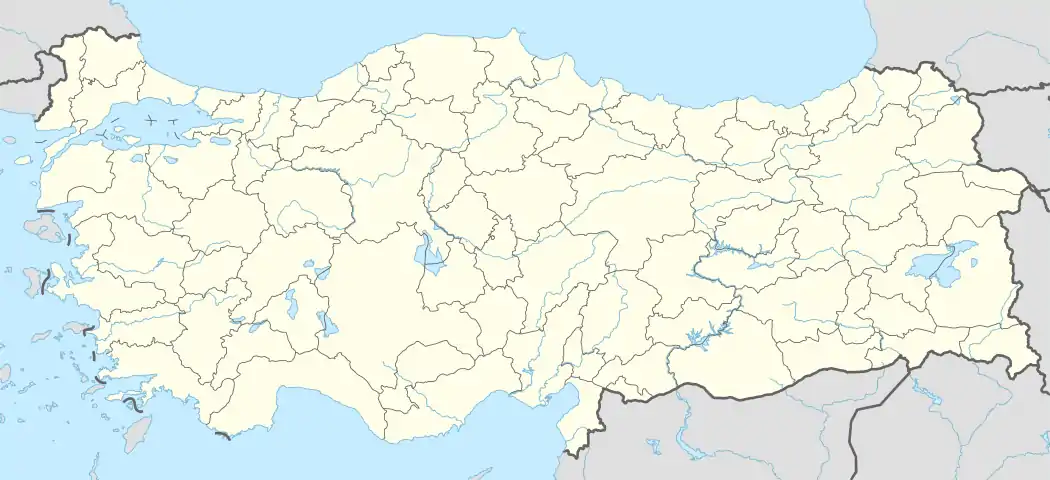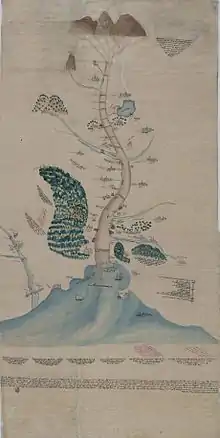Kızılırmak Delta
The Kızılırmak Delta (Turkish: Kızılırmak Deltası) is the delta of the Kızılırmak River. It is the biggest wetland in the Black Sea Region[2] and is one of several internationally important[3] Ramsar sites in Turkey. All of the first and second delta plains and most of the third delta plain is dominated by agriculture.[4] It is important for biodiversity of plants and birds.[5] It is 40 km from Samsun.[6]
| Kızılırmak Delta | |
|---|---|
| Kızılırmak Deltası | |
 The delta from a bridge over the river | |
 | |
| Location | Bafra, Samsun Province |
| Coordinates | 41°36′N 36°05′E |
| Website | kizilirmakdeltasi www www www |
| Official name | Kizilirmak Delta |
| Designated | 15 April 1998 |
| Reference no. | 942[1] |
Lakes
Some lake water is eutrophic due to agricultural pollution.[7]
Biology
Birds
White stork breed here[8] and there are many other species such as: grey-headed swamphen, great white egret. There is a bird ringing station.[9]
Reptiles
Reptile species found in the delta are Greek tortoise, European pond turtle, the lizard Darevskia saxicola, European green lizard, Balkan green lizard, slow worm, European cat snake, Caspian whipsnake, grass snake, dice snake, and horned viper.[10]
Amphibians
Of the 9 species of amphibians found in the delta, 2 species are salamanders and 7 species are frogs. The main species in the area; banded salamander (Triturus vittatus), rough salamander (Triturus karaelinii), warty toad, toad (Bufo bufo), green toad (Bufo viridis), tree frog (Hyla arborea), earth frog, agile frog (Rana dalmatin), and Uludağ toad (Rana macrocnemis).[10]
Threats
A 2020 study found both sewage and agricultural pollution in the channels.[12] Gendarmes are stationed to prevent illegal hunting.[13] Pumping of groundwater causes seawater intrusion.[14]
Management
Some traditional practices help with the management: for example water buffalo and fishing boats help keep the connections between the lakes open.[15]
History

Festivals included a stork feast, spring release of water buffaloes, and sheep breeding.[15] Traditionally it is considered sinful to kill certain animals and plants always or at certain times of year.[15] In 2016 it was inscribed in the tentative list of World Heritage Sites in Turkey.[16]
References
- "Kizilirmak Delta". Ramsar Sites Information Service. Retrieved 25 April 2018.
- "38 Black Sea wetlands to visit" (PDF). Archived from the original (PDF) on 2014-04-14.
- "Ramsar Sites of Turkey".
- Ozesmi, Uygar (2006). "Ecosystems in the Mind: Fuzzy Cognitive Maps of the Kizilirmak Delta Wetlands in Turkey". arXiv:q-bio/0603022.
- "Doğa". Archived from the original on 2014-04-14.
- Centre, UNESCO World Heritage. "Kızılırmak Delta Wetland and Bird Sanctuary". UNESCO World Heritage Centre. Retrieved 2019-03-14.
- "Ramsar Information Sheet" (PDF).
- Yavuz, Kiraz Erciyas; Yavuz, Nizamettin; Tavares, José; Barış, Y. Sancar (2012). "Nesting habits and breeding success of the White Stork, Ciconia ciconia, in the Kızılırmak delta, Turkey". Zoology in the Middle East. 57: 19–26. doi:10.1080/09397140.2012.10648959. S2CID 87042198.
- Özkoç, Ömral Ü; Oğuz, Deniz; Nacar, Can; Erciyas-Yavuz, Kiraz; Barış, Y. Sancar (2020-01-02). "Red-flanked Bluetail Tarsiger cyanurus recorded at the Turkish Black Sea coast for the first time". Zoology in the Middle East. 66 (1): 91–93. doi:10.1080/09397140.2020.1711629. ISSN 0939-7140. S2CID 213663552.
- "Kızılırmak Deltası, Kuş Cenneti ve Mandacılık".
- "Biological Data Derived from Sturgeon (Acipenser stellatus, Acipenser gueldenstaedtii and Huso huso) by-catch along the Coasts of the Southern Black Sea (Turkey)" (PDF). Turkish Journal of Fisheries and Aquatic Sciences.
- Şener, Şehnaz; Şener, Erhan; Varol, Simge (2020-11-01). "Hydro-chemical and microbiological pollution assessment of irrigation water in Kızılırmak Delta (Turkey)". Environmental Pollution. 266 (Pt 1): 115214. doi:10.1016/j.envpol.2020.115214. ISSN 0269-7491. PMID 32688111.
- DHA. "Kızılırmak Deltası'nı, atlı jandarma timi koruyor". Hürriyet (in Turkish). Retrieved 2021-01-08.
- Ersoy, Arzu FIRAT; Turan, Nazlı AYYILDIZ; Özgül, Hava YILDIZ (2020-10-15). "Kızılırmak Delta Kıyı Alanındaki Tuzlanma Sürecinin Stuyfzand Hidrojeokimyasal Modelleme Sistemi ile Değerlendirilmesi". Gümüşhane Üniversitesi Fen Bilimleri Enstitüsü Dergisi (in Turkish). 10 (4): 949–960. doi:10.17714/gumusfenbil.727322. ISSN 2146-538X.
- Gül, Seyfullah (2020). "Kızılırmak Deltasında Yazılmamış Kanunlar: Bir Sulak Alanın Korunmasında Geleneksel Ekolojik Bilginin Rolü". International Journal of Geography and Geography Education. 25 (42): 321–324. ISSN 2630-6336.
- "Kızılırmak Delta Wetland and Bird Sanctuary". UNESCO World Heritage Centre. UNESCO. Retrieved 4 June 2018.
Further reading
- Natural Protected Areas of the Wetland and Bird Paradise in the Kizilirmak Delta in Samsun: 2019-2023 Management Plan Environment Ministry
- Scaramelli, Caterina. How to Make a Wetland: Water and Moral Ecology in Turkey.
External links
| Wikivoyage has a travel guide for Kızılırmak Delta Bird Reserve. |
 Media related to Kızılırmak Delta at Wikimedia Commons
Media related to Kızılırmak Delta at Wikimedia Commons- Wings over Wetlands Critical Site Network (CSN) Tool
- Nature Association
- Official video